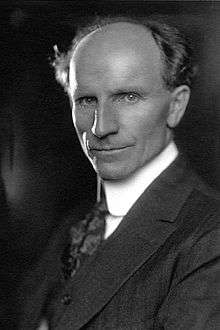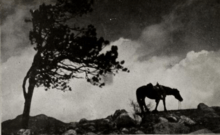Enos Mills

Enos Abijah Mills (April 22, 1870 – September 21, 1922)[1] was an American naturalist, author and homesteader. He was the main figure behind the creation of Rocky Mountain National Park.
Early and personal life
Mills was born in Pleasanton, Kansas, near the later site of the Mine Creek Battlefield of the Civil War. His parents were Enos Mills, Sr., and Ann Lamb Mills. He had ten brothers and sisters, who are listed in order of birth: Augustus, Elkhanah, Mary, Naomi Victoria, Ruth, Sarah, Ellen, Sabina Isabelle (Belle), Horace, Enoch Joe.[2] He married Esther Burnell on August 12, 1918. Their only child, Enda Mills, was born on April 27, 1919.
Colorado and Montana
He moved to Colorado in 1884 at the age of 14.[3] He suffered from an unidentifiable illness which he later discovered to be an allergy to wheat.
At age 15, he made his first ascent of Longs Peak. Over the course of his life, he made the trip 40 times by himself and nearly 300 additional times as a guide.[4] He built his homestead near Longs Peak and the town of Estes Park, Colorado at the age of 15, completing it at 16.
In the winter of 1887 he moved to Butte, Montana.[4] There he lived and worked intermittently until 1902, spending some of his summers traveling the West Coast of the United States, Alaska, and Europe. In 1889, he had a chance encounter with famed naturalist John Muir on a San Francisco beach, and from that point on Mills dedicated his life to conservation activism, lecturing, and writing.[4]
In 1902, Mills returned to Colorado and purchased the Longs Peak House near Estes Park from his cousin, Elkanah Lamb.[4][5] Mills hired and trained nature guides there, who guided many people up Longs Peak and the surrounding area. His methods of nature interpretation are still taught to students in the field of interpretation.
From 1902 to 1906, Mills was a Colorado State Snow Observer, a position in which he measured the snow depths to predict spring and summer runoff. Following this position, he served as government lecturer on forestry from 1907–1909.[4]
Naturalist and author

Mills authored several articles and books on nature and Estes Park area, beginning in the first decade of the 20th century.[4] His speeches generally focused on the lives of trees, forestry issues, preservation of natural lands, and the lives of wild animals. Often in his speeches and written articles he encouraged people of all ages to get outside and into nature.
Mills continued to lecture and write books until his death.[4]
Rocky Mountain National Park
Mills led the fight to preserve the area around Longs Peak as a national park, and used his speeches, his writing, and photography to lobby for the park.[4][6] He wanted a park of about 1,000 square miles that would cover the area from Wyoming to Pikes Peak.[7] Mills was aided by groups such as the Sierra Club and the Daughters of the American Revolution,[4] American Civic Association, and the General Federation of Women's Clubs. [7] President Woodrow Wilson signed into law the bill that made the Rocky Mountain National Park the tenth national park on January 26, 1915.[7] It was 352.5 square miles.[7] He was called the "Father of Rocky Mountain National Park"[4] by the Denver Post.
Death
Mills died at age 52 in 1922.[4] He died from blood poisoning from an infected tooth.
His wife, Esther Burnell Mills, was co-author with Hildegarde Hawthorne, on the book Enos Mills of the Rockies, which was published in 1935.[8] Mills Lake, within the Rocky Mountain National Park, was named in his honor.[3]
Publications
_(17938372305).jpg)
- The Story of Estes Park and Guide Book. Denver: Outdoor Life Publishing Company. 1905. LCCN 05016610.
- Wild Life on the Rockies. Boston, New York: Houghton Mifflin Company. 1909. LCCN 09008919.
- The Spell of the Rockies. Boston: Houghton Mifflin Company. 1911. LCCN 11029625.
- In Beaver World. Boston, New York: Houghton Mifflin Company. 1913. LCCN 13005458.
- The Rocky Mountain Wonderland. Boston, New York: Houghton Mifflin Company. 1915. LCCN 15007322.
- The Story of Scotch. Boston, New York: Houghton Mifflin Company. 1916. LCCN 16018586.
- Your National Parks. Boston, New York: Houghton Mifflin Company. 1917. LCCN 17014711.
- The Grizzly, Our Greatest Wild Animal. Boston, New York: Houghton Mifflin Company. 1919. LCCN 19010216.
- The Adventures of a Nature Guide. Garden City, New York: Doubleday, Page and Company. 1920. LCCN 87893116.
- Waiting in the Wilderness. Garden City, NY and Toronto: Doubleday, Page and Company. 1921. LCCN 21002306.
- Wild Animal Homesteads. Garden City, NY: Doubleday, Page and Company. 1922. LCCN 23026340.
- Watched By Wild Animals. Garden City, NY: Doubleday, Page and Company. 1923. LCCN 42046087.
- The Rocky Mountain National Park. Garden City, NY: Doubleday, Page and Company. 1924. LCCN 24008898.
- Bird Memories of the Rockies. Boston, New York: Houghton Mifflin Company. 1931. LCCN 31019666.
References
- ↑ Wild, Peter; Skov, Arny (illus.) (1979). Enos Mills. Western Writers Series #36. Boise, Idaho: Boise State University. p. 47. ISBN 978-0884300601. OCLC 6006498.
- ↑ "Enos A. Mills Lineage". www.enosmills.com. Retrieved 2015-11-02.
- 1 2 Malitz, Jerome (2005). Rocky Mountain National Park Dayhiker's Guide. Big Earth Publishing. p. 45. ISBN 978-1-55566-340-7.
- 1 2 3 4 5 6 7 8 9 10 11
 This article incorporates public domain material from the National Park Service document: "Biography of Enos Mills" (PDF). National Park Service. November 19, 2016.
This article incorporates public domain material from the National Park Service document: "Biography of Enos Mills" (PDF). National Park Service. November 19, 2016. - ↑ Jennsen, Kenneth (January 1, 2015). "Lambs and Mills made names as early Rocky Mountain National Park guides". Reporter Herald. Retrieved November 16, 2016.
- ↑ Malitz, Jerome (2005). Rocky Mountain National Park Dayhiker's Guide. Big Earth Publishing. p. 10. ISBN 978-1-55566-340-7.
- 1 2 3 4 Malitz, Jerome (2005). Rocky Mountain National Park Dayhiker's Guide. Big Earth Publishing. pp. 7–8. ISBN 978-1-55566-340-7.
- ↑ Mills, Esther Burnell; Hawthorne, Hildegarde (1935). Enos Mills of the Rockies. Random House.
Further reading
- Mills, Esther Burnell; Hawthorne, Hildegarde (1934). Enos Mills of the Rockies. Houghton Mifflin.
- Wild, Peter (July 29, 1977). "The Father of Rocky Mountain Park: Enos Abijah Mills". High Country News. Launder, WY: 1, 6–7.
- Wild, Peter (1979). "Enos Mills: Propagandist of the Rocky Mountains". Pioneer Conservations of Western America. Missoula, MT: Mountain Publishing. pp. 71–79.
External links
- Short radio episode "Universal Kinship" from The Adventures of a Nature Guide, 1920, by Enos A. Mills, California Legacy Project.
- Works by Enos Mills at Project Gutenberg
- Works by or about Enos Mills at Internet Archive
- Works by Enos Mills at LibriVox (public domain audiobooks)

- Enos Mills Cabin Website